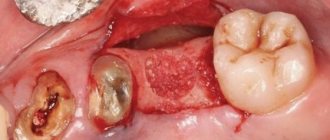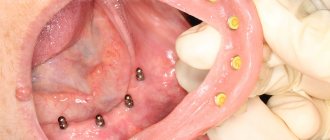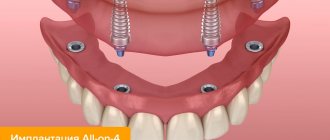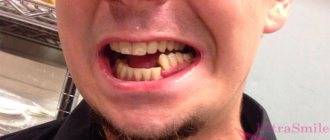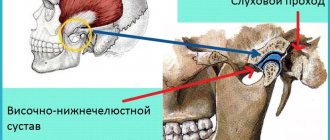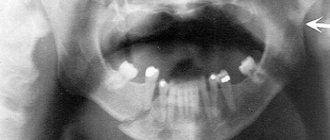The main methods of treating missing lower teeth
In the case where a tooth is completely missing (even the root is missing), restoration of the lower jaw teeth is carried out using one of the methods below:
- Installation of a fixed bridge prosthesis. The method is used when one or more teeth are destroyed or lost; the remaining healthy teeth serve as supports for the bridge structure. Fixed dentures cannot redistribute the chewing load on the jaw; therefore, when chewing, the load is not distributed evenly, but only on the supporting teeth to which the denture is attached. The fixation of fixed dentures is permanent, and it is impossible to remove such dentures yourself without the help of a dentist. The advantages of the method are aesthetic characteristics, restoration of chewing function, fast treatment time and relative low cost compared to dental implantation. Disadvantages - the need to depulp possibly healthy teeth, uneven distribution of the load, ongoing atrophy of the bone tissue of the alveolar crest in places where teeth are missing.
- Use of removable dentures. Most often they are used for long-term defects in the dentition (the absence of 3 or more teeth in a row). However, sometimes they are used in the absence of only 1-2 teeth (butterfly dentures) - if the patient does not want to undergo implantation or grind adjacent teeth for crowns. It is recommended to remove removable dentures once a day for hygienic procedures. Such dentures are less comfortable than fixed ones, because... occupy a significantly larger volume. Due to anatomical features, removable dentures for the lower teeth are smaller in size than the upper ones. Advantages: low cost, minimally invasive treatment, acceptable aesthetics. Disadvantages - does not restore chewing function, does not prevent bone tissue atrophy, the need for daily removal and periodic relining.
- Dental implantation. Implants are installed both when one or several teeth are lost in a row. Their purpose is to replace the biological root of a tooth; in prosthetics, implants are used as supports for artificial crowns: metal-ceramic or ceramic with a zirconium dioxide frame. Three main stages of implantation: installation of the implant into the bone tissue, formation of aesthetic gums, fixation of abutments on the implants and installation of crowns on the abutments. Implants can also be used in cases of complete absence of teeth in the lower jaw. The main advantage of implantation is the almost complete restoration of chewing function, and, as a result, the cessation of bone atrophy; such prosthetics also provide excellent aesthetics.
If the root of the tooth is not removed and there is a possibility of preserving it for use under a fixed prosthesis, the stump of the tooth is first restored, onto which a crown - metal-ceramic or completely ceramic - is fixed.
Symptoms
Signs indicating the formation of a deep bite:
- The upper jaw grows and develops more rapidly than the lower jaw, surpassing it in parameters;
- The lower lip is too thin (in most cases!) and can be turned outward;
- Reduced depth of the gap located in front between the lips and cheeks;
- Lack of space between rows of teeth;
- Unnaturally small chin size.
Patients with a deep bite usually complain of difficulty biting and chewing foods, distorted pronunciation of certain sounds, and difficulty breathing.
Classification
Main types of deep bite:
| Name | Description | Peculiarities |
| Distal | The chin is reduced and slanted to the side, the face is shortened, the lower jaw is underdeveloped. When you smile, your teeth and part of your gums are visible. | Shapes:
|
| Neutral | It is not visually noticeable in either children or adults. The facial features are proportional. Accompanied by the formation of a supramental fold, in which the lower incisors overlap the upper ones. The chin is proportional to the rest of the face. | Affects the articulation of sounds and pronunciation. Only a specialist can determine a neutral deep bite. |
Consequences
A deep bite causes aesthetic discomfort and negatively affects the main function of the jaw – chewing. The mucous membranes are constantly injured, the front teeth are overloaded and bruxism (grinding) is formed.
Due to regular friction, tooth enamel wears down, which leads to increased sensitivity. A deep bite negatively affects the functioning of the maxillofacial joints, so treatment must begin as early as possible.
A long-term complication of the pathology is the gradual loosening of teeth and their loss already at 30-35 years of age. A deep bite provokes the development of many diseases - periodontitis, gingivitis and interdental gaps.
Photos before and after treatment
Diagnostics
To identify a defect and make a correct diagnosis, the orthodontist carefully examines the oral cavity and receives complaints from the patient. In order to recreate the exact contact of the dentition, casts are made from alginate mass. For a more detailed assessment of the condition of the oral cavity, computed tomography (CT), electromyography and orthopantomography are used.
Attention! Sometimes a specialist uses photographs of a person’s face taken from several angles to identify the occlusal relationships of the dentition.
Treatment
Correction of deep bites is recommended in childhood, but the necessary dental care is also provided to adult patients. The selection of treatment methods takes into account the form and degree of the anomaly:
- Plastic surgery for frenulum correction. The techniques used are frenectomy or frenulotomy. Laser exposure can be used;
- Bracket systems. They are able to correct the bite when the position of the incisors and molars is fully formed. Vestibular and lingual structures are used for treatment;
- Veneers, crowns. A cosmetic method that masks a deep bite, BUT does not eliminate the causes of its occurrence;
- Osteotomy. A surgical intervention that involves separating the palate and upper jaw from the bones and fixing them with plates and screws.
Attention! Elimination of malocclusion before the age of 6 years is recommended with the use of removable vestibular plates and retainers.
Treatment of a deep bite is accompanied by wearing a special plate and performing muscle gymnastics exercises.
At home
Self-treatment of deep bite is IMPOSSIBLE. However, at home you can speed up the healing process with the help of migymnastics. Provided that the exercises are performed correctly and regularly, it allows you to achieve excellent results.
When performing exercises, follow several rules:
- use all areas of the oral cavity,
- maintain the greatest amplitude of execution,
- take a break after each exercise,
- Perform exercises until your muscles feel slightly tired.
Prevention of functional disorders
A deep bite cannot be eliminated in 1-2 days; treatment with braces can take years. Simple preventive measures will help prevent functional disorders.
Among them:
- elimination of caries,
- correction of incorrect posture,
- eating solid foods (nuts, carrots),
- exclusion of pathologies of the skeletal system,
- prevention of somatic and chronic diseases.
The key to oral health is regular dental examinations (at least 2 times annually).
Patient reviews
“I wore braces for a long time - as a result, the bite improved a little, but still caused discomfort. To permanently solve the problem, the dentist suggested surgery. I had it performed under general anesthesia, the swelling subsided in just a few days, and 16 days after the operation I went back to work! Finally, my smile doesn’t give me any complexes, and eating food doesn’t cause any inconvenience!”
Lyudmila, 28 years old, Samara.
“After installing the braces system, I experienced severe pain for several days and could not even eat. The dentist warned about such consequences, so I bought painkillers in advance. After about a week I was completely accustomed to the braces. Now I’ve been wearing them for 6 months and the improvement in my facial proportions is already noticeable!”
Anastasia, 21 years old, Saratov.
“A deep bite has tormented me since childhood, but 2 years ago I finally decided to correct it and turned to an orthodontist. Initially, it was corrected with braces, but the doctor warned that it would be impossible to do without surgical intervention. Now my bite has been completely restored (after braces and surgery), even the oval of my face has visually stretched. For prevention, I continue to perform myogymnastics. I'm happy with the result."
Alexey, 34 years old, St. Petersburg.
Implantation of lower teeth is the best solution
Dental implants are artificial tooth roots, most often made of titanium (can also be ceramic or tantalum), a biocompatible metal, or its alloys. The word is made up of the Latin "im" meaning "inside" and "planta" meaning "sapling". Thus, implantology deals with replacing lost tooth roots with artificial ones through the installation of dental implants.
Implants for the lower jaw in the absence of teeth are inserted into the bone tissue, and then the dentist fixes a crown, fixed bridge or removable denture on them. Dental implants not only maintain the strength of your chewing muscles, but also strengthen your jaw bones. They help maintain facial proportions. Dental restoration with implants helps prevent the signs of aging. After implantation, patients look younger.
According to foreign statistics accumulated since the 1960s, the service life of a correctly installed implant ranges from 20 years to life. The service life depends significantly on the patient’s discipline in oral hygiene.
How much do the best dentures cost?
| Construction type | Price |
| Crowns | From 12,000 rubles for metal ceramics to 40,000 for zirconium crowns |
| Veneers | 20,000 – 55,000 rubles per unit |
| Partial denture on implants | From 70,000 rubles |
| Classic bridge | On average 8,000 – 15,000 rubles |
| Complete denture on implants | 150,000 – 600,000 rubles for one jaw. Depends on the number and brand of implants implanted. |
| Butterfly prosthesis | From 4,000 rubles depending on the material |
| Plate dentures | From 20,000 rubles. 30,000 – 35,000 rubles for Quadrotti prostheses |
| Removable complete denture | On average 35,000 rubles for a full Acry Free prosthesis |
| Removable denture on mini-implants | 100,000–120,000 rubles for one jaw |
Publisher: Expert magazine about dentistry Startsmile.ru
Features of implantation of lower chewing teeth
The chewing teeth of the lower jaw bear the highest load. Implantation of the lower teeth should be carried out after preliminary planning and modeling of future teeth, since in some cases, the artificial root will have to withstand the load, which was previously distributed over 3-4 natural tooth roots. And the chewing force is calculated to be at least 30 - 40 kg per tooth.
Another argument in favor of planning is that the diameter of the implant neck is smaller than the conventional neck diameter of the biological posterior tooth, which means that the shoulder between the crown and the implant will be larger, and any deviation of the implant axis from the direction of the application axis will lead to greater negative consequences.
Therefore, classical implantation with preliminary planning, in two stages with delayed loading, is an ideal option for restoring lower chewing teeth. That is, first an implant is installed, and then, a few months later, a permanent crown is fixed onto it.
Sometimes, before dental implantation, bone grafting is required - a surgical operation to build up bone tissue at the site where the implant is supposed to be installed. The fact is that for implantation to be effective, certain parameters of bone tissue are required - height, width and density, and if tooth extraction was traumatic or a lot of time passed between tooth loss and implantation, then most likely the bone has atrophied.
Features of implantation of lower front teeth
In modern humans, the chewing load on the front teeth, due to a specific diet, is small. People rarely use their incisors to bite tough foods; in recent centuries, they have been using a knife and fork more often. Rather, healthy and beautiful teeth in the smile area emphasize its beauty and certain life values of their owner.
Therefore, the decisive factor in choosing a method of prosthetics for the lower front teeth will be the most complete imitation of the appearance of a natural tooth.
The most aesthetic result is achieved with the help of metal-free ceramic prostheses on a zirconium dioxide frame, which are most often used in the manufacture of anterior dental implants. The abutment must also be made of zirconia.
An excellent result can be achieved by using metal-ceramic crowns, but in certain lighting, this may be noticeable to others... Although this applies more to the upper front teeth.
